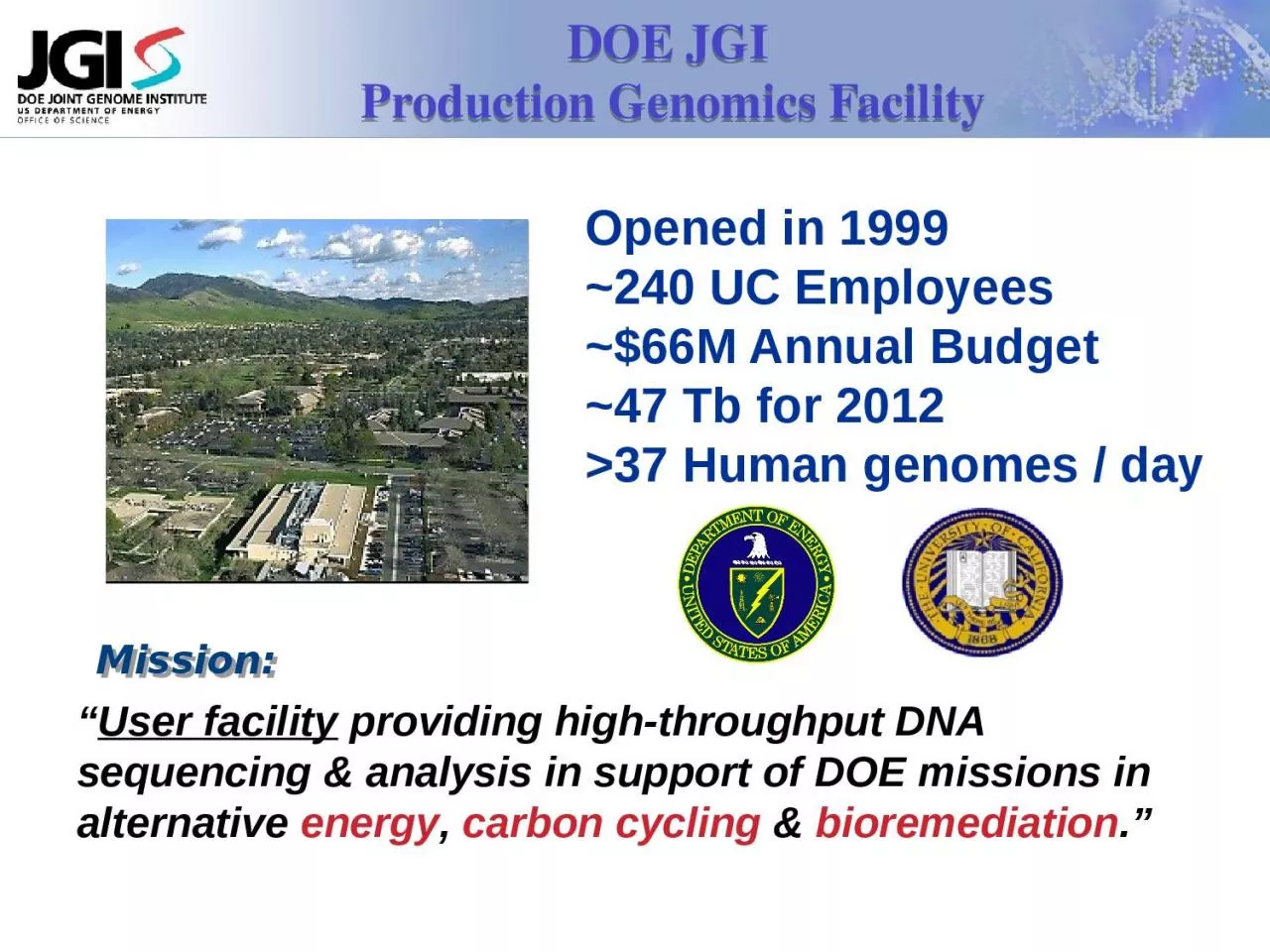

User facility providing highthroughput DNA sequencing amp analysis in support of DOE missions in alternative energy carbon cycling amp bioremediation Opened in 1999 240 UC Employees ID: 932043
Download Presentation The PPT/PDF document "DOE JGI Production Genomics Facility" is the property of its rightful owner. Permission is granted to download and print the materials on this web site for personal, non-commercial use only, and to display it on your personal computer provided you do not modify the materials and that you retain all copyright notices contained in the materials. By downloading content from our website, you accept the terms of this agreement.
Slide1
DOE JGI Production Genomics Facility
“
User facility providing high-throughput DNA sequencing & analysis in support of DOE missions in alternative energy, carbon cycling & bioremediation.”
Opened in 1999~240 UC Employees~$66M Annual Budget~47 Tb for 2012>37 Human genomes / day
Mission:
Slide2{
{
{
FY2009
49 Units
24 FTEs
$11M
1Tb
FY2010
22 Units
15 FTEs
$11M
6Tb
FY201115 Units9 FTEs$8M29Tb
Evolution of JGI Sequencing Platforms
Budget ($M)
Staff (#)
Output (Tb)
3730
454
GAii
Hiseq
454
454
GAii
GAii
Hiseq
Slide3JGI Science Programs
Slide4DOE JGI
Community Sequencing Program
>700 Users
Slide5SCIENCE GOALS
Slide6Program Science
2012 - Focus Areas
Slide7Microbial
Genomics
Nikos
Kyrpides
Microbial Genomics and
Metagenomics
Programs
DOE Joint Genome institute
Slide8Overview of the talk
Historical perspective Do we need more sequencing?
Major Transitions in Genomics
Slide9Slide10"To understand life[unlike understanding an electron]you must understand its history"
Carl R. Woese
The Quest for Darwin’s Grail
Slide11"The time will come I believe, though I shall not live to see it, when we shall have fairly true genealogical trees of each great kingdom of nature"
Darwin's Dream
[in a letter to T.H. Huxley] Charles Darwin, 1857
Slide12Quotes from “The Microbial World”1st Edition –1957
2nd Edition –1963
3rd Edition – 1970
4th Edition – 1977
“It is a waste of time to attempt a natural system of classification for bacteria”
“The only possible conclusion is, accordingly that the ultimate scientific goal of biological classification cannot be achieved in the case of bacteria”
Verbatim repeat of the 3rd edition
“For bacteria, the general course of evolution will probably never be known, and there is simply not enough objective evidence to base their classification on phylogenetic grounds”
Slide131978 – 1st Universal Tree of Life
Slide14History of Genomics
Slide15Microbial Genomics“Genome sequencing has come of age, and genomics will become central to microbiology’s future. It may appear at the moment that the human genome is the main focus and primary goal of genome sequencing, but do not be deceived. The real justification in the long run, is
microbial genomics.”
1998Carl Woese
Slide16GREAT CHALLENGES
1995-2009
2010-2015
Finished
1000
3000
Draft
1000
10000
Genes
8 Million
52 Million
P. Chain
et al.
Science, 2009
2010-20133,000
20,00092 Million
UNDERSTANDING
vs INFORMATION
Slide17Why we need more sequencing
Ribokinase family
Fructokinase family
2-dehydro-3-deoxy
glucokinase family
Slide18We need to change this …
71 bacterial genomes
Genome projects 2000
5500 bacterial genomes
Genome projects 2010
11%
Slide19Many Phyla – many gaps
Poor sequence coverage mainly due to lack of isolates, but many gaps have unsequenced representatives
Norman Pace
Slide20Culturable
Unculturable
What about the Uncultured majority?99% of microorganisms are not culturable with present methods.
Slide21Binning
Metagenomic
Analysis
Acid Mine Drainage
Sargasso Sea
Soil
1 10 100 1000 1000s 10000
Species complexity
Human Gut
Termite Hindgut
?
The road to success in
Metagenomics
is through Microbial Genomics
Source: Susannah
Tringe
, JGI
Reference Genomes
Slide22Availability of Reference Genomes
Acid Mine Drainage
Human gut
Soil
100% 60% 50% 40% 20% 1%
Reference Genomes
Termite Gut
Marine
?
Slide23Known diversity of cultured
vs
uncultured organisms
Number of Organisms
16S
rRNA Distance
Number of Organisms
Coverage of Cultured Microbes with Genome Projects
16S
rRNA
Distance
Genomes and
Metagenomes
Slide24GEBA
Goal:Filling in the gaps in sequencing along the bacterial and archaeal branches of the Tree of Life
Wu et al. Nature 2009
Status: >120 Complete >100 Draft >100 In progresshttp://img.jgi.doe.gov/GEBA
Slide25Wu et al. Nature 2009
Improved Gene annotation and characterization of hypothetical gene families based on
novel gene fusions: 7.7 times more fusion events than any other randomly selected 56 genomes
novel gene neighbourhoods: 4.3 times more novel gene neighbourhoods than any other randomly selected 56 genomesnovel connections of protein families:
47 times more novel connections of protein families than any other randomly selected 56 genomes
Mavromatis
Amrita
Pati
Slide26Wu et al. Nature 2009
Rob Knight
~ 35,000 OTUs
Slide27Victor Kunin, JGIDino Liolios, GOLD
The
Microbial Earth ProjectSTEERING COMMITTEE
Nikos Kyrpides, DOE-JGIGeorge Garrity, Names4LifeHans-Peter Klenk, DSMZPhil Hugenholtz, JGI
Slide28Microbial Earth Project
Slide29Slide30Prochlorococcus
marinus Pangenome
10
Listeria monocytogenes
Pangenome
17
15
Staphylococcus
aureus
Pangenome
Pangenomes
Slide31Strain / species diversity
Slide3214765
2733
= 5.4
10434
5820
= 1.8
Slide33Reference Genome
Best Blast Hit
Pangenome
Metagenome Analysiswith
Pangenomes
Slide34PANGENOMESHOW REPRESENTATIVE OF THE SPECIES IS THE PANGENOME?
PANGENOME
☺
☺
☺
☺
☺
☺
☺
☺
16S DIVERSITY
☺
☺☺☺
☺☺☺☺
☺☺
Slide35PARADIGM SHIFT
1960-1990
16S RNA
1990-2010
Genomes
2010-2020
Pangenomes
Slide36Microbial Genomics Program